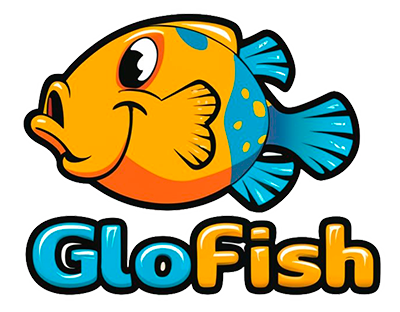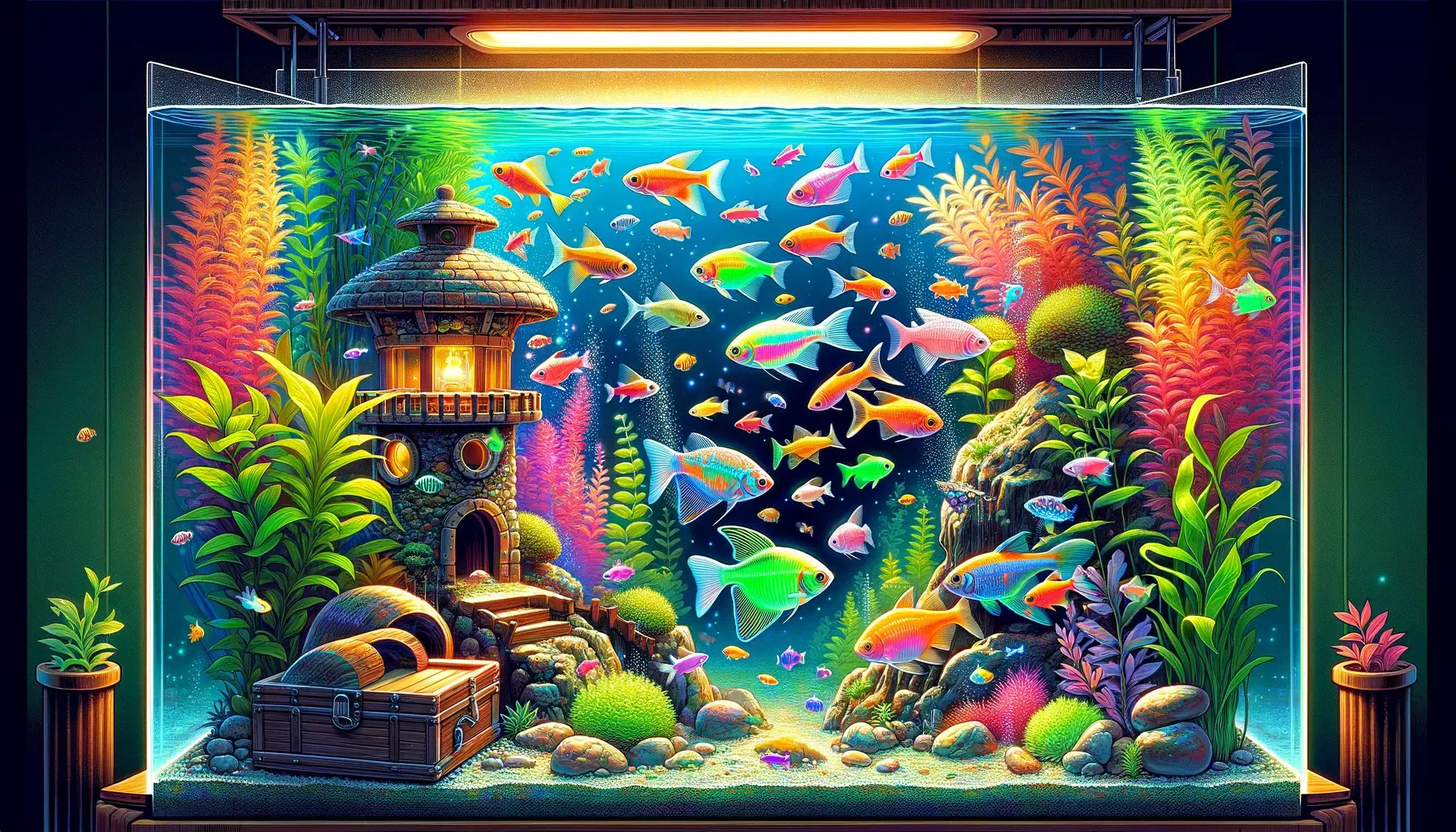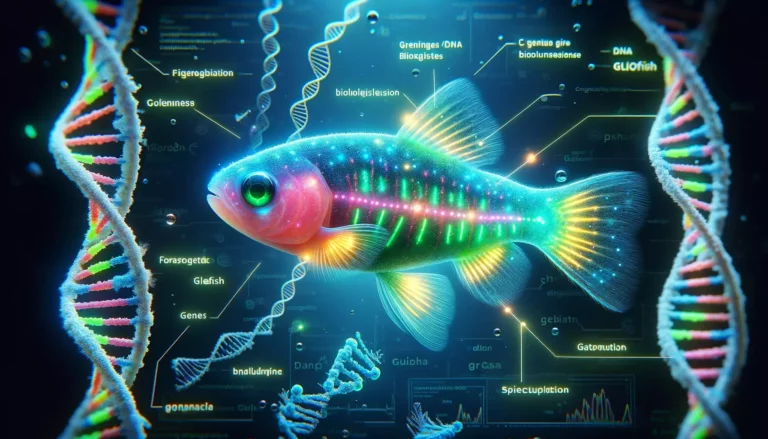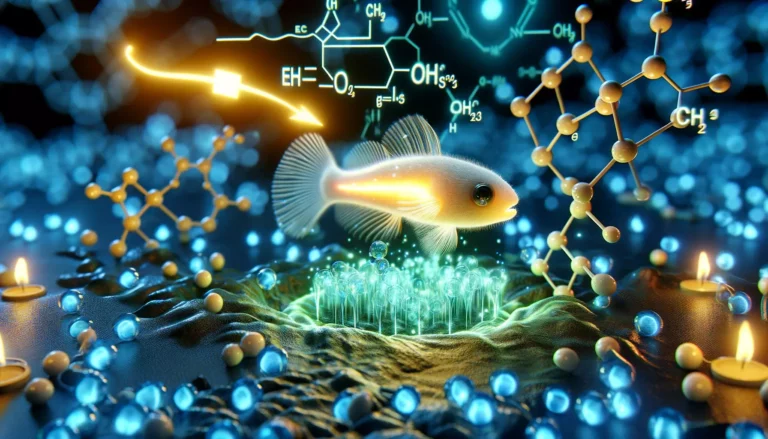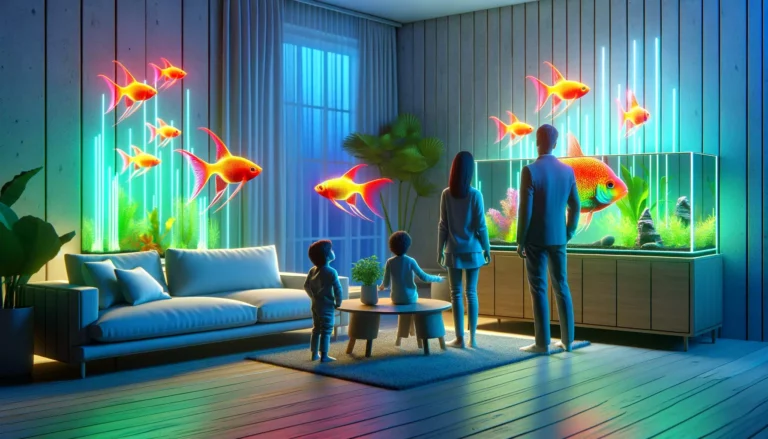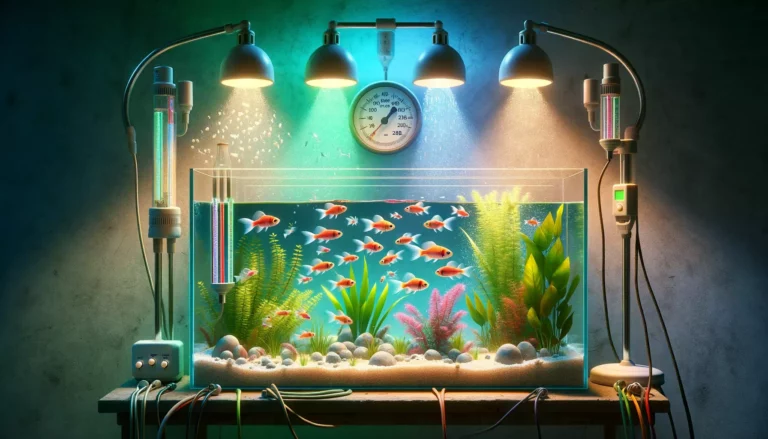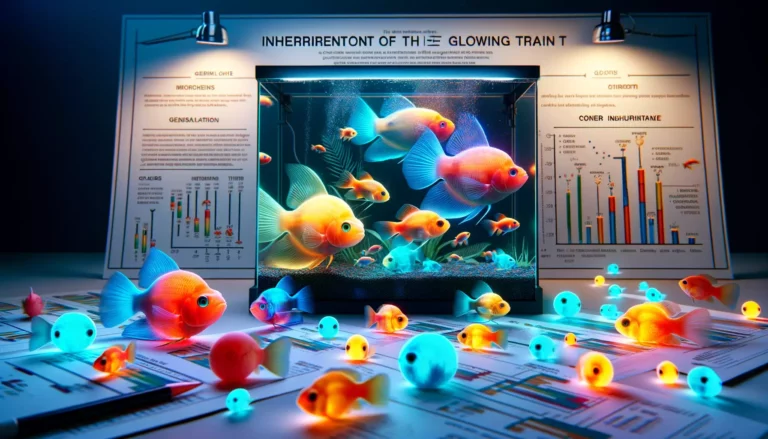Comprehensive Guide to GloFish: Varieties and Care
GloFish are a unique type of aquarium fish. They stand out with their bright, neon colors. Originally, GloFish were regular fish like Zebra Danios. Then scientists modified them for a special purpose. They wanted to help track environmental changes. This was done using a gene that makes them glow.
Over time, GloFish became popular as pets. Their glowing colors come from genes of fluorescent corals and jellyfish. Now, there are various GloFish types, like Tetras and Barbs. Each type has its own range of glowing colors. They are the same as their non-glowing counterparts in behavior and care needs.
History and Development of GloFish
GloFish have a fascinating history. Their story begins with environmental research. Scientists used them to detect pollutants in water. When exposed to toxins, the fish would glow. This was a groundbreaking way to monitor water quality.
The first GloFish were Zebra Danios. They were modified in the early 2000s. The glowing gene made them easy to study. Soon, their unique appearance caught the public’s eye. This led to their introduction into the aquarium trade. Now, GloFish are bred for their beauty, not just for research.
Explanation of Genetic Modification in GloFish
Genetic modification in GloFish is an intricate process. Scientists insert a gene from a fluorescent organism. This gene is responsible for their bright colors. The process is precise and controlled. It ensures the fish are healthy and vibrant.
The modification happens at the embryonic stage. This means all offspring inherit the glowing trait. It’s a permanent change. The fish pass this trait to their young. So, all GloFish have the fluorescent gene naturally from birth.
Genetic Engineering and its Role in GloFish Coloration
GloFish coloration comes from genetic engineering. This science involves altering an organism’s DNA. For GloFish, scientists add a gene that produces a fluorescent protein. This gene comes from marine animals like jellyfish and corals.
This added gene is what makes GloFish glow. When exposed to black lights, they shine brightly. This is due to the fluorescent proteins reflecting light. Each color of GloFish has a specific type of protein. For example, green GloFish have a protein from jellyfish. Red ones might have a protein from sea anemones.
Safety and Ethical Considerations
Safety and ethics are crucial in GloFish creation. All procedures follow strict guidelines. This ensures the fish are not harmed. The genes added to GloFish are safe for the fish and the environment.
GloFish are not harmful to other fish. They are just like their non-modified counterparts in behavior. The ethical aspect also includes their care and breeding. Breeders and pet owners must ensure these fish live in suitable conditions. Their welfare is always a priority.
Zebra Danio Varieties

Zebra Danios are the original GloFish variety. They come in several vibrant colors. Each color variant adds a unique charm to aquariums. Let’s explore these colorful options:
- Starfire Red: These Danios display a deep, glowing red hue. They stand out beautifully in any tank setting.
- Electric Green: This variant shines in a bright, neon green. It’s reminiscent of glowing green coral.
- Sunburst Orange: As the name suggests, these fish glow in a warm orange tone. They add a fiery touch to the aquarium.
- Cosmic Blue: Cosmic Blue Danios have a striking, deep blue glow. They mirror the look of a starry night sky.
- Galactic Purple: A rare color, Galactic Purple adds a regal touch. These fish glow in a soft, lavender-like purple.
Ideal Habitat and Care Requirements
Zebra Danios are hardy and adaptable, making them great for beginners. Their care is straightforward, but attention to detail is important. Here are key points for their habitat and care:
- Tank Size: A minimum of 10 gallons is recommended. Zebra Danios are active and enjoy space to swim.
- Water Conditions: Keep the temperature between 65-77°F (18-25°C). They prefer a pH level of 6.5-7.2. Regular water changes are essential for their health.
- Group Dynamics: Zebra Danios are social fish. A group of at least five helps them feel secure and active.
- Tank Setup: They enjoy a tank with ample swimming space. Plants and hiding spots are good for their wellbeing. Avoid sharp decorations that could harm their delicate bodies.
- Lighting: Normal aquarium lighting is fine. However, UV or blue lights can enhance their glow.
- Diet: They are omnivorous. A mix of high-quality flake food, small pellets, and occasional live food is ideal.
Providing the right environment and care is key to their well-being. With proper care, Zebra Danios can thrive and bring vibrant life to any aquarium.
Creating the Ideal GloFish Aquarium
Setting up the perfect aquarium for GloFish is both an art and a science. An ideal GloFish aquarium combines functionality with visual appeal. Here’s how you can create the perfect home for your GloFish:
- Choose the Right Tank Size: The tank size depends on the type of GloFish. Danios and Tetras do well in a 10-20 gallon tank, while Barbs and Sharks need at least 20-30 gallons. More space is always better.
- Filtration System: A good filter is essential. It keeps the water clean and maintains the right flow for GloFish. Choose one that suits the size of your tank and the needs of your fish.
- Substrate and Decorations: Use gravel or sand as a substrate. Decorations like rocks, driftwood, and live or artificial plants not only add beauty but also provide hiding places for your fish.
- Heating and Temperature: Most GloFish thrive in temperatures between 72-80°F (22-27°C). A reliable aquarium heater will help maintain a consistent temperature.
Tank Setup Recommendations for Different GloFish
Different GloFish species have slightly varying requirements:
- Danios and Tetras: They prefer a tank with open swimming spaces and some planted areas. They are active swimmers and enjoy a bit of current.
- Barbs: These are also active and need space to swim. Include more plants and hiding spots to manage their nippiness.
- Sharks and Bettas: GloFish Sharks require larger tanks with ample space to swim and explore. Bettas, on the other hand, need a peaceful setup with minimal current and plenty of hiding places.
Lighting and Environmental Needs
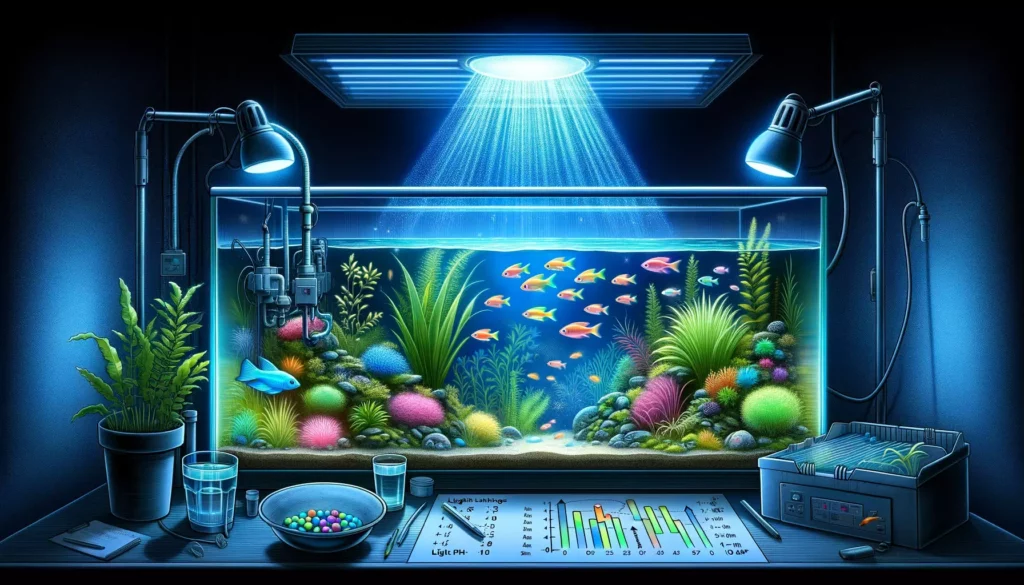
Lighting plays a crucial role in showcasing GloFish’s vibrant colors. Here’s how to light up your GloFish tank:
- Specialized GloFish Lighting: These lights are designed to enhance the fluorescent colors of GloFish. They usually emit blue light, which makes the fish glow brilliantly.
- Natural Daylight Cycles: Besides the aesthetic aspect, it’s important to mimic natural daylight cycles. This means having a consistent light schedule, with around 10-12 hours of light each day.
- Temperature and Water Quality: Regularly check and maintain water temperature and quality. The pH should be in the range suitable for the specific type of GloFish you have.
Creating the right environment is key to your GloFish’s health and happiness. With proper setup and maintenance, your GloFish aquarium will be a thriving, vibrant ecosystem.
F.A.Q.
The world of GloFish can be fascinating and full of questions, especially for new enthusiasts. Here, we compile some common queries and provide expert answers and advice.
Can GloFish live with other fish?
- Answer: Yes, GloFish can live with other non-aggressive fish of similar size. It’s important to avoid fish known for fin-nipping. Always consider the temperaments and environmental needs of all fish in the tank.
Do GloFish need a special type of food?
- Answer: GloFish do not require special food. They thrive on high-quality fish food suitable for their species (Danio, Tetra, Barb, etc.). A varied diet including flakes, pellets, and occasional live or frozen treats is recommended.
How long do GloFish live?
- Answer: With proper care, GloFish can live as long as their non-genetically modified counterparts, typically 3-5 years. Good tank conditions and diet are key to their longevity.
Do GloFish require special lighting?
- Answer: While special lighting is not required for their survival, certain lights can enhance their colors. Blue and black lights are particularly effective in making GloFish colors more vibrant.
Is it ethical to keep GloFish?
- Answer: The ethics of keeping GloFish is a personal decision. They are bred under regulated conditions and do not suffer from their genetic modification. As with any pet, providing a caring and suitable environment is crucial.
Can GloFish reproduce? Will the babies also glow?
- Answer: GloFish can reproduce, and their offspring will also inherit the glowing trait. However, breeding GloFish is discouraged for hobbyists, as it raises both ethical and legal concerns.
How do I set up a GloFish tank?
- Answer: A GloFish tank should have a good filtration system, appropriate lighting, and a heater if needed. Decorate with plants and hiding spots. The tank size and setup depend on the GloFish species you have.
Are there any specific health issues to watch for in GloFish?
- Answer: GloFish are prone to the same health issues as their non-modified counterparts. Watch for signs like lethargy, loss of appetite, or discoloration. Maintaining clean water and a stress-free environment is crucial.
By addressing these FAQs, both new and experienced GloFish owners can gain a better understanding and ensure the best care for their vibrant pets. Remember, the key to a healthy GloFish is a well-maintained tank and a balanced diet.
